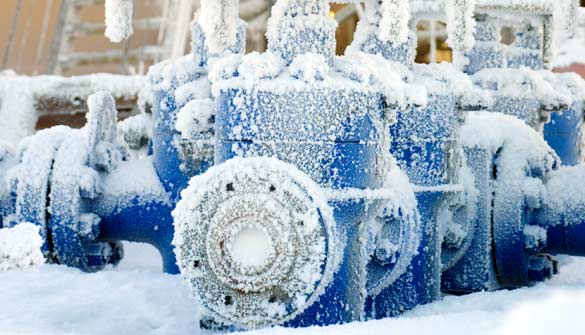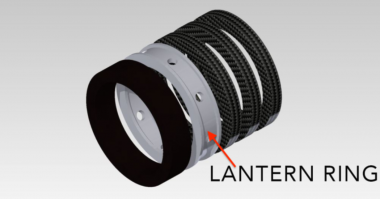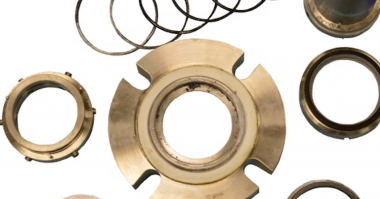Author: Steve Jagels, Precision Polymer Engineering, an IDEX Company, USA
Throughout the world, more challenging fields are being developed in the oil and gas industry, and valves are required to perform in sour conditions that involve expanded temperature ranges along with pressure cycles. In oil and gas valve applications, seal performance is often a limiting factor and knowing the effects of low temperature and sour gas (H2S) on elastomers is critical. While many engineers can comfortably specify metals for valves in extreme environments, experts in sealing understand that the performance limitations of the elastomers will determine a successful seal. This article will review the limitations associated with low temperature performance and sour gas resistance, outlining specifications, such as NORSOK M170 annex A, which pertain to pressure and temperature cycling and sour gas service.
Use of Elastomer Seals in Valves
Changes to the elasticity of an elastomeric material due to time or physical environment can impact the reliability of a seal, it has been shown that chemical degradation of an elastomer will change its low temperature performance [1]. It is, therefore, reasonable that a valve with a long maintenance interval will need sealing materials that have little change in properties whether by thermal or chemical processes throughout the service life of the seal.
High temperature resistance is well known and established as a key property of materials for oil and gas valve applications. However, two properties in particular, namely low temperature resilience and sour gas resistance, are not normally found in the same elastomer. Both properties are important for valves used in the industry as exploration and production of hydrocarbons moves to more inhospitable regions.
Material Performance
Of the different elastomer types, there are general properties that are fundamental to each group such as temperature range, chemical resistance, and glass transition temperature. However, each of these materials will have trade-offs in performance in sour gas and low temperature resilience as shown in Table 1. There are three materials that are fully resistant to sour gas (FEPM, FFKM, & Low Temp FFKM) and among the elastomer types shown, only low temperature FFKM (perfluoroelastomers) have low temperature capabilities below 0°C.
Table 1: Shows the relative sour gas resistance of elastomer types and their respective glass transitions, approximate low and high temperature performance. A rating of 1 on the sour gas resistance indicates the elastomer does not react to hydrogen sulfide.
Specifications
The major Oil and Gas industry specifications for sour gas resistance, such as NORSOK M-710, are shown in table 2.
Table 2: A list of commonly used industry specification for sour gas resistance of elastomers. The test methods are similar in that they immerse a polymer sampler in a vessel containing a mixture of gasses and hydrocarbon liquids.
However, the low temperature performance of an elastomer valve seal is not easily defined. While there are a number of test methods for determining low temperature properties of an elastomer, the results from the test may not correlate with the performance of an actual seal in application.
There are a number of factors that can affect an O-ring’s low temperature performance beyond the polymer’s glass transition, and a definitive relationship between lab results and service performance is not well established. Additionally, the fluid within an application may permeate the polymer and improve low temperature properties [2]. In recent years, the determination of the glass transition via differential scanning calorimetry (DSC) has become more prevalent in industry as an analytical technique used to compare the relative low temperature performance of different elastomeric materials in the laboratory.
There are many individual testing methods and specifications that can provide information about an elastomer but they are not designed to tell the engineer about real-world functionality. Rigorous testing and experience bridges the knowledge gaps and reveals more about performance, informing the valve engineer and guiding the seal selection for successful PR2 qualification and functional testing.
Using NORSOK M-710 annex A methodology, it is shown that exposure of elastomer specimens to sour fluid conditions at elevated temperature will accelerate aging and provide information about long term material stability. FFKMs and FEPMs show no change in properties after aging suggesting there is no chemical attack from H2S, while FKMs and HNBRs will show a loss of elongation in H2S. Using DSC, the glass transition can be determined. The glass transition of low temperature FFKMs is -32°C, meaning it will maintain flexibility and resilience during pressure cycling tests. This has been confirmed by valve manufacturers running real-life PR2 qualifications. Among the elastomers that show no deterioration in sour conditions, only low temperature FFKM will have resilience at a temperature viable for subsea or arctic conditions.
In critical seals that require broad temperature performance, especially low temperature elasticity and H2S resistance in oil and gas applications, experts in sealing believe there is only one material that can meet all of the requirements: low temperature FFKM.
To find out more about sealing solutions for your needs, please visit: www.prepol.com.
About PPE
Precision Polymer Engineering Ltd (PPE) is a leading provider of high performance O-rings, elastomer moldings and sealing solutions to a diverse range of industries. The company develops novel elastomer materials to meet the most demanding sealing applications including extreme temperatures and chemically aggressive environments. Its markets are global, and include oil & gas industries, semiconductor manufacturing equipment, food and pharmaceutical production, chemical processing, large-bore diesel engines and aerospace.
Founded in 1975, PPE has manufacturing facilities in Europe and the US and sales offices and dealers in the US, Europe and Asia. The company’s success is based on developing sealing solutions that perform in difficult applications, last longer, require less maintenance and deliver the lowest cost of ownership, combined with exceptional levels of customer service and technical support. Precision Polymer Engineering is a Unit of IDEX Corporation and operates alongside FTL Technology within the IDEX Sealing Solutions group segment.
Reference
[1] Tripathy, B. & Smith, K. (1998) The Myth About Low Temperature Performance of Fluoroelastomers in Oil Seal Applications. International Congress and Exhibition. 980850, p. 5 Detroit MI: SAE International.
[2] Warren, PD. (2007) Low Temperature Sealing Capability of O-Rings: The Relationship Between Laboratory Tests and Service Performance Under Varying Conditions. High Performance and Specialty Elastomers Fourth International Conference Proceedings. Smithers Rapra Technology.




![Durlon Chemap® filters solve filtration tasks in a simpleand economic way [Case Study]](https://test.empoweringpumps.com/wp-content/uploads/2022/12/Durlon-Chemap®-filters-solve-filtration-tasks-in-a-simpleand-economic-way-Case-Study-7-380x199.png)


Comments